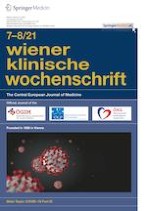05.02.2021 | original article
Influence of age and gender on the epidemic of COVID-19
Evidence from 177 countries and territories—an exploratory, ecological study
Erschienen in: Wiener klinische Wochenschrift | Ausgabe 7-8/2021
Einloggen, um Zugang zu erhaltenSummary
Background
The pandemic of coronavirus disease 2019 (COVID-19) is spreading worldwide with an uncertain ultimate impact on every aspect of human society. Recognizing the groups with higher susceptibility and fatality are in urgent need.
Methods
We retrieved the total number of confirmed incident and death cases of COVID-19 in 177 countries/territories from the Center for Systems Science and Engineering (CSSE) at Johns Hopkins University (JHU). Data of age and gender composition were collected from the United Nations Department of Economic and Social Affairs. Spearman’s correlation analysis was used to explore the association between the composition of age and gender and the incidence rate (IRC), case fatality rate (CFRC), and mortality rate of COVID-19 (MRC). Multiple comparisons were adjusted by the Bonferroni method, and the threshold p-value was set as p < 0.01. Software SPSS 23.0, ArcGIS 10.6, and GraphPad Prism 8.0 were used to generate our results.
Results
Median age was positively correlated to IRC, CFRC and MRC (rs = 0.60; rs = 0.27; rs = 0.61, p < 0.0001 for all). The age-dependent correlation between people over 65 years of age with IRC was higher in females, while the correlation between age distribution and CFRC as well as MRC was higher in males (p < 0.0001 for all). Besides, we found the age-gender-dependent differences were correlated to IRC in places with high income and associated with CFRC in non-high income countries/territories.
Conclusion
The correlation between the composition of age and gender and the epidemic characteristics of COVID-19 confirmed previous points that females are more susceptible to COVID-19. The results remind us that more attention should be paid to male patients, particularly those over 65 years old for enhanced clinical management.
Anzeige
